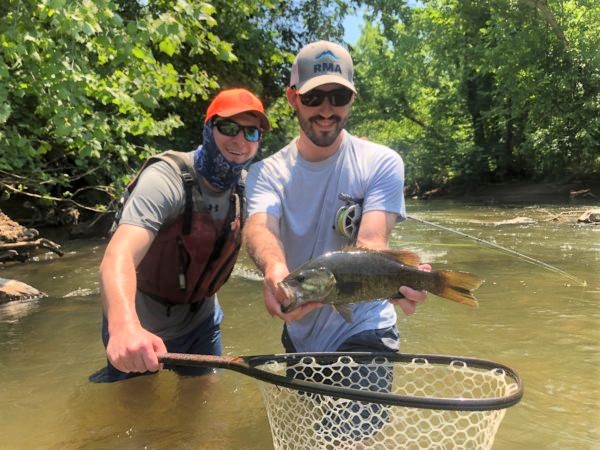
By Alex McCrickard, DWR Aquatic Education Coordinator
During the dog days of summer, many anglers put their rods and reels down and are content to wait until later in the fall for cooler weather. Unfortunately, these anglers end up missing some of the most exciting warm water fishing conditions of the year. During this time frame, I tend to focus my efforts on one species of fish in Virginia, smallmouth bass. Pound for pound and inch for inch, these fish fight harder than most other freshwater fish in the state.
Smallmouth Bass in Virginia
Smallmouth bass, frequently referred to as smallies or bronzebacks, are a freshwater member of the sunfish family Centrarchidae. Their green and brown sides are often marked with vertical black bars. Some of these fish have war-paint-like markings extending horizontally and diagonally behind their eyes and across their gill plates.
Smallmouth bass are native to the Great Lakes system and the Mississippi River Basin including the Tennessee and Big Sandy River Drainages of Southwest Virginia. However, these game fish have been introduced all across the Piedmont of Virginia and are truly a worthy opponent on rod and reel.
Because of the smallmouth’s widespread range in Virginia, they are readily available to anglers fishing west of the coastal plains above the fall lines of our major river systems. This allows anglers who reside in cities and large metropolitan areas to fish local as smallmouth opportunities are plentiful.
The James River in Lynchburg and Richmond, the Rappahannock River in Fredericksburg, the Rivanna River in Charlottesville, the Maury River near Lexington, and the New River in Southwest Virginia are fine examples of local opportunities.
The mainstem and larger tributaries of these rivers are full of smallmouth. Anglers in Northern Virginia can focus efforts on the Upper Potomac River as well as the Shenandoah mainstem, North Fork, and South Fork. The North Fork of the Holston River and the Clinch River provide excellent smallmouth opportunities in Southwest Virginia.
Floating these larger rivers in a canoe or raft can be a great way to cover water. Just remember to wear your life jacket. You can also wade-fish these rivers and their tributaries, especially in the lower flows of late summer.
Summer Conditions
My favorite conditions to fish for smallmouth are from mid-summer into early fall. During this time of the year our rivers and streams are typically at lower flows with fantastic water clarity. These conditions provide for some incredible sight-fishing opportunities for smallmouth bass. Look for fish to be holding against steep banks with overhanging trees and vegetation. During the middle of hot summer days it can pay off huge when you find a shady bank with depth and current. It can also be productive to target riffles and pocket water during this time of the year. Smallmouth will often be in the faster and more oxygenated water when river temperatures get hot.
It’s important to think about structure when locating summer smallmouth. These fish will often be found along a rock ledge or drop off.
During hot, bright, summer days, the fishing can be most productive early in the morning and again in the evening. I try to fish during these times as smallmouth will often be active during low light conditions and can get sluggish during the middle of a hot bright afternoon.
That being said, these fish can be caught in the middle of bright sunny days as well. Also, afternoon cloud cover and a light shower can turn the fishing on in a matter of moments.
Rods/Reels & Tackle/Approach
Medium to medium-light spinning and baitcasting rods in the 7-foot range are great for late summer smallmouth. It can pay off to scale down in low clear water. You may want to consider fishing 6-8-lb. test instead of 10-12 lb. Soft plastics work well for smallmouth, and favorites include swim baits and tubes.
Topwater baits are a late summer “go to” with low and clear water. Try fishing buzzbaits, the smaller Whopper Plopper 90, Zara Spooks, and Heddon Tiny Torpedos. Buzzbaits and Whopper Ploppers can be retrieved quickly across the surface enticing explosive takes. The rotating tail of the Whopper Plopper acts like a propeller and creates lots of noise and attention.
For fly fishing, 9- to 10-foot rods in the 6 to 8 weight range are best. You will want a heavier rod on our larger rivers. Heavier rods in the 7 to 8 weight range will also turn over some of the bigger bugs we tend to throw this time of year on floating fly lines.
Don’t let the dog days of summer keep you from missing some of the most exciting warm-water fishing conditions of the year. Late-summer smallmouth should be on your angling to-do list. The conditions during this time of the year are excellent for sight fishing and cater to a topwater approach. From the smaller tributaries to the larger rivers, smallmouth opportunities are diverse across the state. Make time to get out this summer and fish local in Virginia.
